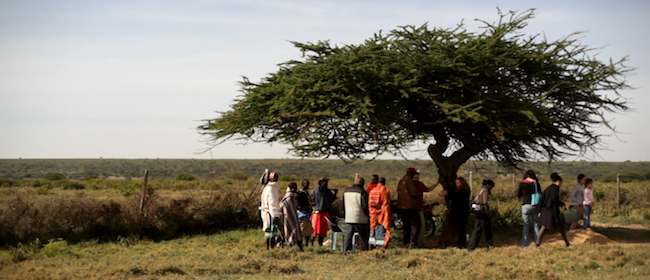Food Forests
The idea of forest gardens (food forests) was first articulated by Robert Hart in his book ‘Forest Gardening’ and subsequently became one of the keystone concepts in Permaculture. A Permaculture forest garden mimics the architecture and beneficial relationships of a natural forest. Food forests are not ‘natural’, but are designed and managed ecosystems that are very rich in biodiversity and productivity. (1) It is based on a philosophy of cooperation with nature and each other; taking responsibility for our impact on population and our consumption of things which have high environmental costs.
A food forest typically is comprised of seven layers: the uppermost layer is the canopy layer that is comprised of tall trees, mostly large fruit and nut trees. Between the tall canopy layer trees there is a layer of low growing fruit trees, and nestled between all these small trees are the shrubs which are represented by currants and berries. Filling the remaining space is the herbaceous layer: these are the culinary and medicinal herbs, companion plants, bee-forage plants, and poultry forage plants. Any remaining space is occupied by ground cover plants which form a living mulch that protects the soil, reduces water loss to evaporation, and prevents weeds from growing. While that might seem like a lot of plants in one space, we still have one more to fill: the upright vertical space. This is filled by climbers and vines, which can be run up fences, trees, or any other vertical support. This category includes grapes, climbing beans, many berries, passion fruit, kiwi fruit, climbing peas, and many other species that love to climb.
The benefits of food forests are as follows: high productivity; natural mulch, compost and fertilizer; natural pest control by using natural predators, and a resilience that can only come through biodiversity.
A food forest is built to emulate a real forest — only we fill it with the food plants and trees that we want. Real forests do not need any work, they self-maintain — no pesticides, herbicides, weeding, crop rotation, mowing or digging. Food forests do not need any of this either!
1 http://www.permaculture.org/nm/index.php/site/Permaculture-Food-Forest/#sthash.MLmXTMlD.dpuf
2 http://foodforest.com.au/about-us/permaculture/
3 http://permaculture.org.au/2011/10/21/why-food-forests/
4 http://permaculture.org.au/2011/10/21/why-food-forests/
5 http://permaculture.org.au/2011/10/21/why-food-forests/
Vegetation
Pressures to cut down pristine forests in Samburu County have been due to the overdependence on natural resources for income. Encroachment on gazette forests and sanctuaries for grazing has increased deforestation and overall degradation of the environment. Trees have been felled for pasture lands so that pastoralist can feed their livestock. Many Samburus also collect firewood, not just for domestic use, but as a source of income through charcoal burningl. Overharvesting of natural resources have led to the destruction of the fragile ecosystem within the County. Traditional land area had been reduced by 40% in 10 years[i]. As of 2006, government statistics indicated that 20% of soil and vegetation cover in Samburu County was “severely damaged” and in need of rehabilitation measures such as reforestation.
“The search for food is the reason I cut down trees. The trees belong to God and taking them is better than stealing from my neighbours. Since the destruction [of the forests] the elephants are gone’”. – Samburu Woman[ii]
Forests play a significant part in the Samburu Landscape. Forests help to regulate water runoff and soil erosion while providing habitat for wildlife. Without healthy functional forests nearby, locals become more vulnerable to floods and droughts, while wildlife is at greater risk for conflict with humans. Currently, 15.5% of total land surface is gazetted indigenous forest cover. Overexploitation of precious tree resources has been for charcoal production, fuel wood, poles, and timber. Three species of trees have been particularly hard hit in the County: Juniperus procera (red pencil cedar), Podocarpus falcantus (podo), and Olea africana (Elgon Olive). All three of these species are threatened or rare throughout the County. In the trust lands, most Cedar, Olea and Podo have been cut and removed due to the high demand for firewood and timber, while gazetted forests have also seen these species exploited for pasture lands and Illegal logging. Gum Arabica and frankincense, along with medicinal herbs, nuts, resins, and gums are also collected by the local population on a significant scale[iii].
The major vegetation types found in Samburu are: Evergreen forest, bush land, semi deciduous bush land/thickets, grassland, and shrubs. One of the greatest threats to this biodiversity is invasive species. As biodiversity decreases it leaves ecosystems more vulnerable to invasive native and non-native species. Due to land degradation many indigenous and exotic plant species have become invasive within the County. Duosperma elemophilu (herb), Sanseveria (succulent herb), and Acacia reficien (bush encroacher) are three indigenous species that have become pervasive throughout degraded rangeland.
Biodiversity
Biodiversity has continued to decline in Samburu County due to the pressures of increasing human and cattle populations. Vast swaths of land, once home to large populations of beautiful and diverse mammals,birds, reptiles, and insects, have been severely degraded due to poor land use management including: over grazing, agricultural production, increased pesticide usage, and pressures of urbanization. Many animal populations are dwindling, some to vulnerably low numbers, while other species that once existed wild in the area are now extinct. People/wildlife conflicts are continually rising in the county.
The African lion (Panthera leo) is a notable case of increasing human and cattle populations contributing to the negative pressures on wild populations. Within the past 15 years, the African lion population in Kenya has been decimated from 15,000 to less than 2,000 individuals [iv]. Today, Samburu County is home to 40 lions [v]. Pastoralists see the lions as a threat to their livelihoods as they prey on their livestock. Whole prides have been poisoned by pesticides or shot by those who perceive them as a threat. The reticulated giraffe (Giraffa camelopardalis reticulata), similarly to the African lion, once roamed the area near Sadhana Forest Kenya in great numbers have been hunted for food to exceedingly low numbers.
Sadhana Forest Kenya’s closest neighbors are zebras. Samburu County is home to two species including the rare Grevy’s zebra (Equus grevyi) or imperial zebra. The most endangered of the three zebra species, the Grevy’s zebra is close to extinction. Its population has declined 50% over the past 20 years, and only 2,000 survive today [vi]. While its natural habitat was across northern Kenya, Eritrea, Somalia, and Ethiopia, currently it is likely that the Grevy’s zebra is extant only in Samburu County [vii]. Unlike the other zebra species, the Grevy’s zebra does not live in harems. If you look closely among the black and white stripes you might just see a single Grevy’s zebra roaming around.
In Samburu County, over 350 species of bird have been recorded [viii]. The Grey Crowned Cranes (Balearica regulorum gibbericeps), noted for their spectacular dances, are an endangered non-migratory bird species spotted in the area of Sadhana Forest Kenya. Their population has declined 50-79% across most of the species’ range in East Africa over the last 45 years due to habitat destruction and wild to captive bird trade [ix]. The wetlands, where Grey Crowned Cranes can be found, have been destroyed due to heavy pesticide usage, and drained for livestock grazing and agricultural production [x]. Currently, there is a wild population of 18,000 in East Africa.
Plant life, just as much as wildlife, play a key role in the health of an ecosystem. It has been recorded that in Samburu County alone, that there are 56 different species of plants that can be used to treat 54 different diseases, including: malaria, digestive disorders, respiratory syndromes and ectoparasites [xi]. Plant based indigenous health systems can help with providing real health security as they are very much alive and are evolving and adapting to modern needs. This information on bio-resource use represents a valuable record for posterity and also a phenomenal bank of information that can be drawn upon to resolve current predicaments. Fortunately, the Samburu pastoralists have preserved their plant-based knowledge to this day. However, much of this information is currently stored among the aging population and this knowledge is rapidly being lost due to Westernization, overgrazing, and over harvesting of plant resources.
Soil is one of the most important non-renewable resources. Samburu County predominately has sandy loam soil, but is dependent on the topography, vegetation cover, and rock type. The soils in the county have varying levels of fertility, depth and drainage, supporting the fragile ecosystem. Many parts of the county are covered by undulating slopes, with shallow soils that are prone to degradation through erosion. Low potential rangelands covers 77.5% of total land surface of the county with 20% of the soil considered severely degraded. Sandy loam soil is found in the surrounding areas of Sadhana Forest Kenya (Lorroki division) [xii].
Reforestation Challenges
There are a few challenges that we face while trying to engage in reforestation in Samburu County. The lives of the Samburu people are largely focused around their livestock. A significant area of land in Samburu County is used for grazing of cattle, sheep, goats, and camels. Planting tree saplings in open unprotected areas would greatly reduce the survival rates of our trees as they would not be easily protected from livestock grazing.
In Kenya we are tackling this problem by giving the people ownership of trees. An important incentive for people to plant and protect these trees is that they are beneficial to them (food forests). The trees are planted around the houses (manyattas) of the Samburu people, creating, for whoever is interested, a small food forest around each house. The people will take care of the small food forest, while these trees will supply each family with some or all of their dietary needs. The people will protect their food forest and we will assist them with creating different tree guards.


